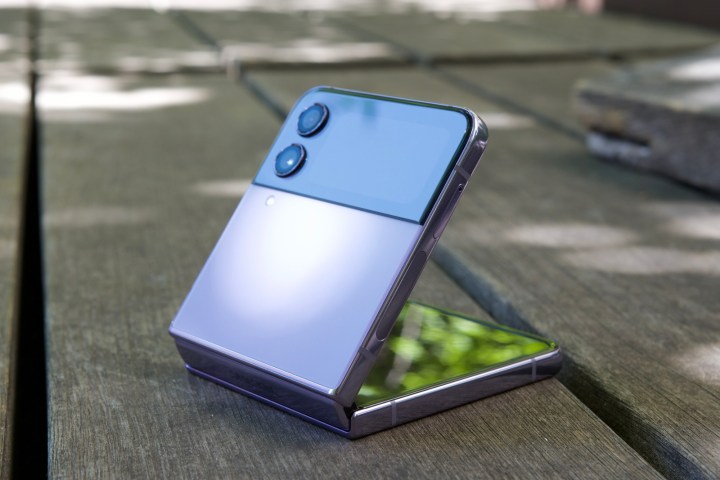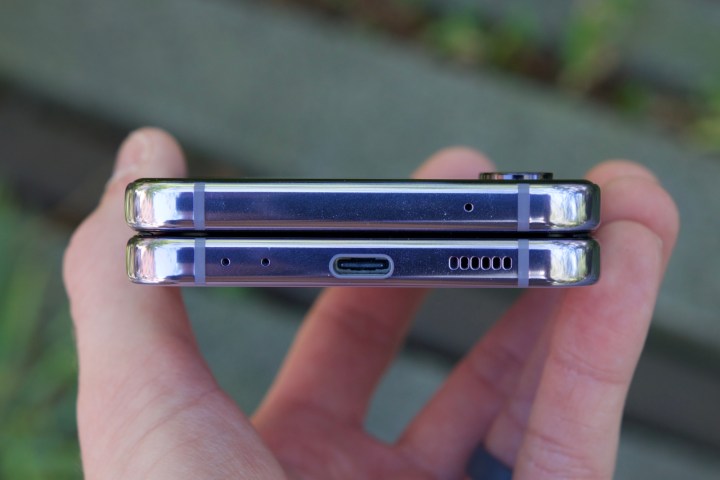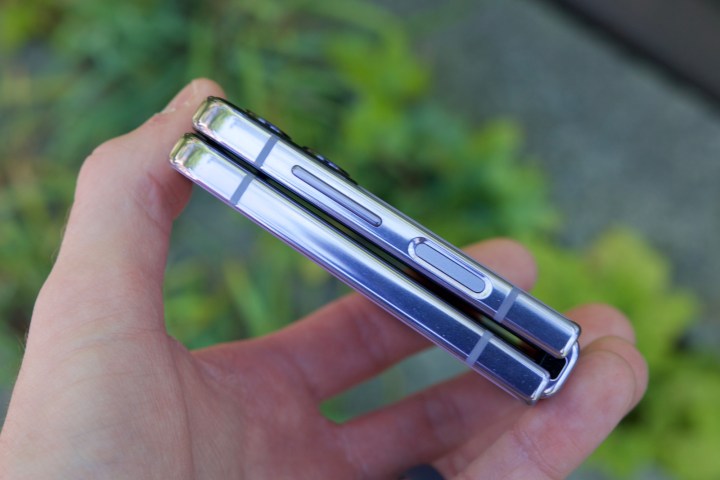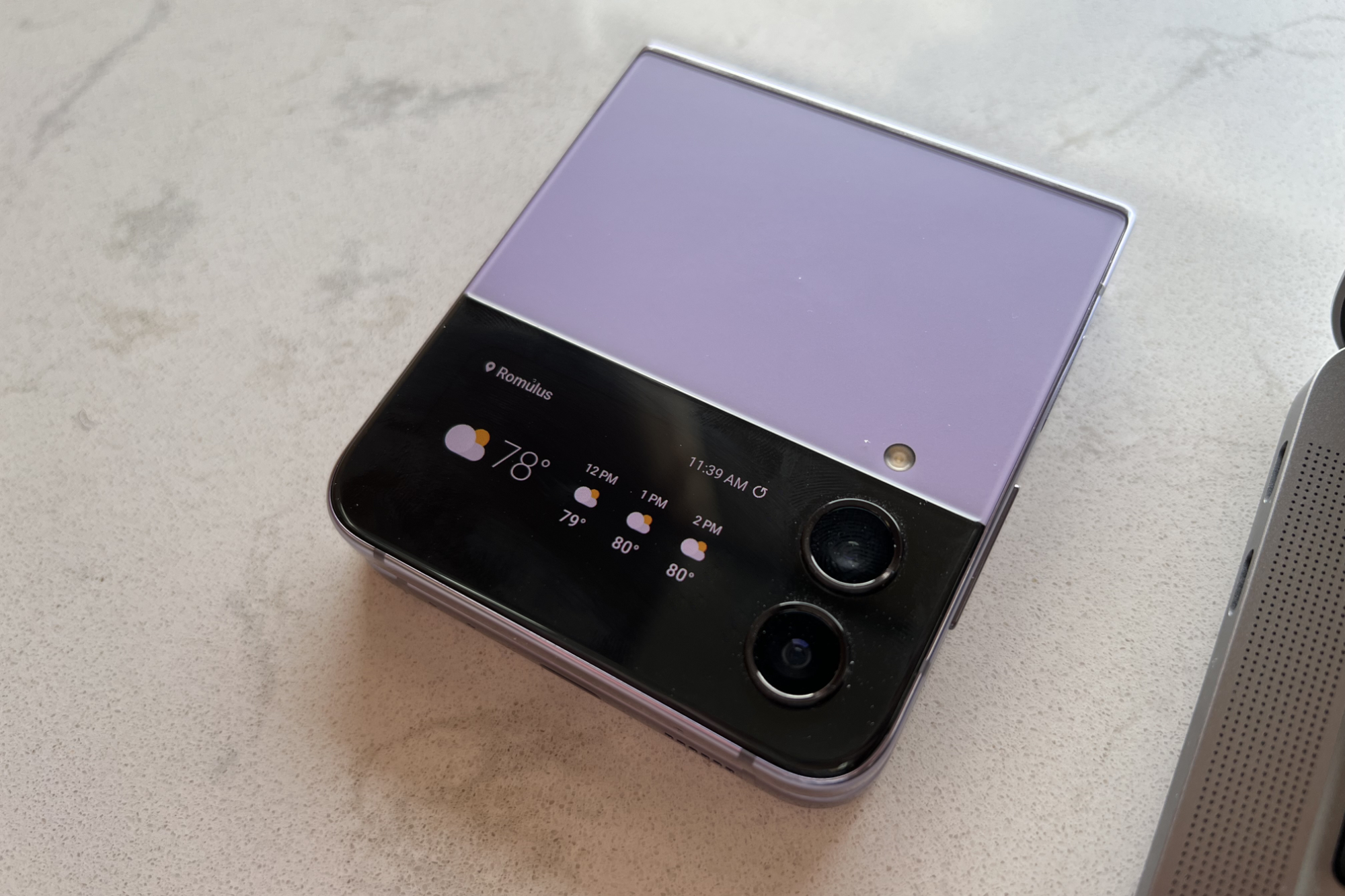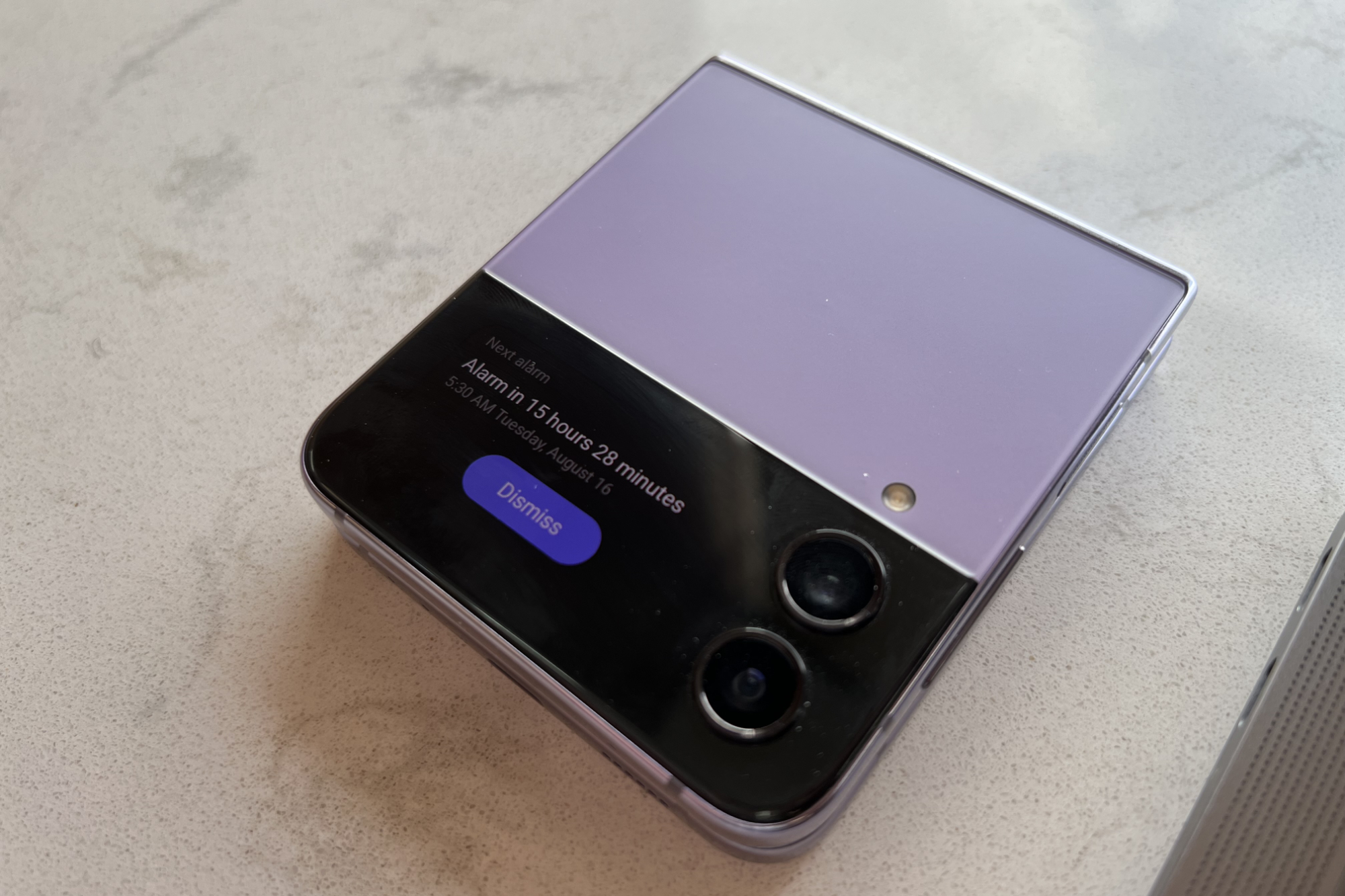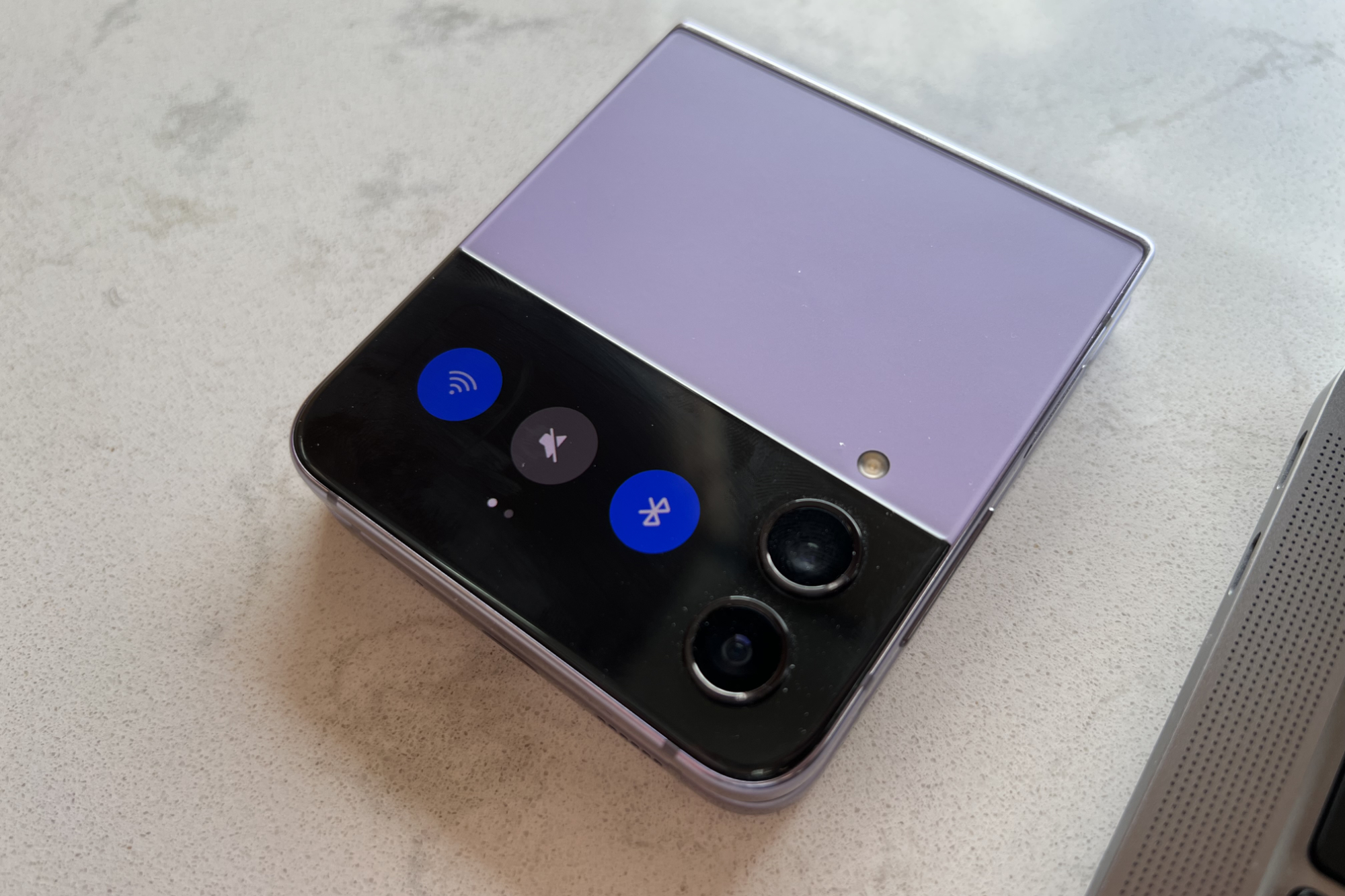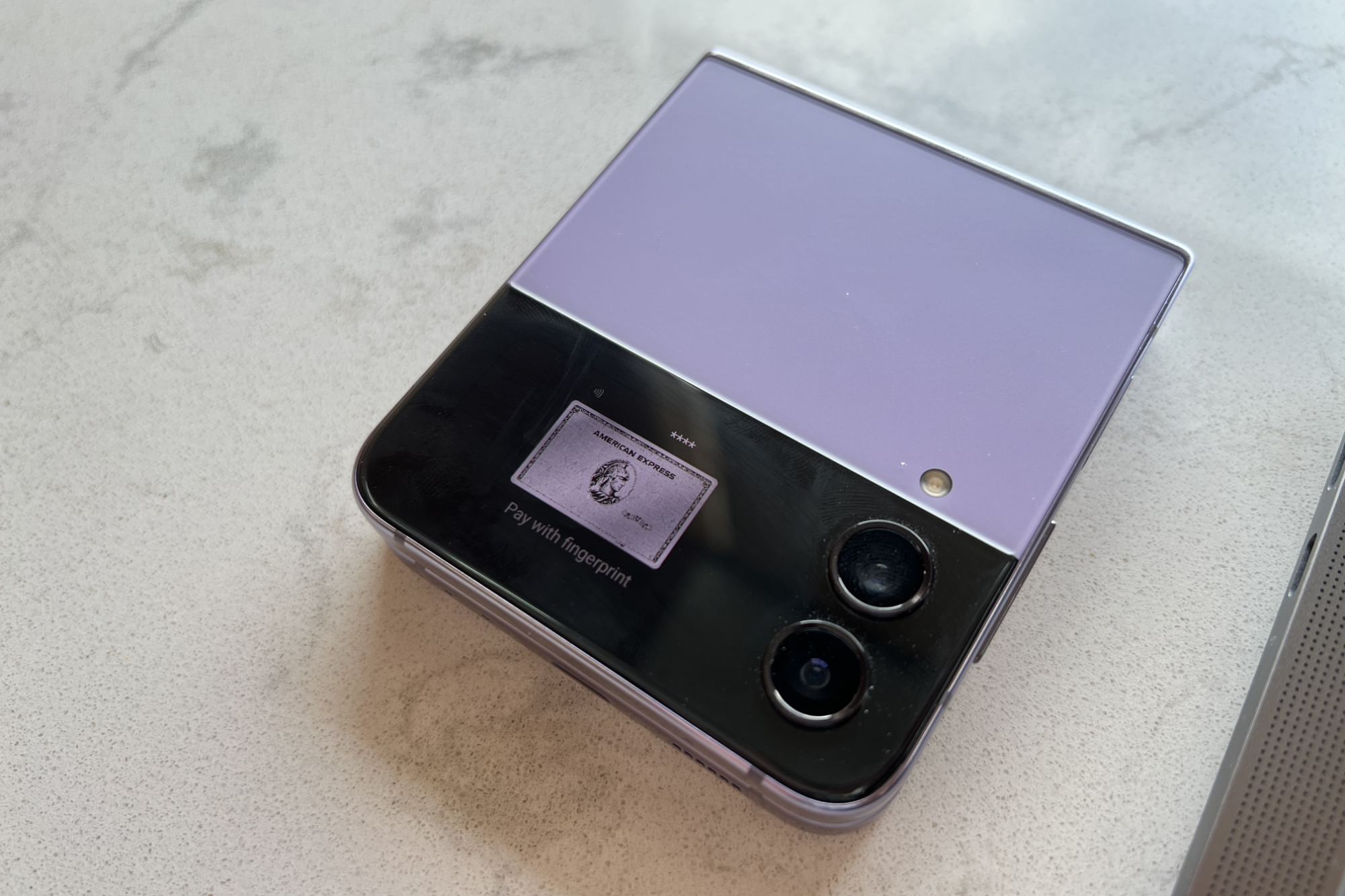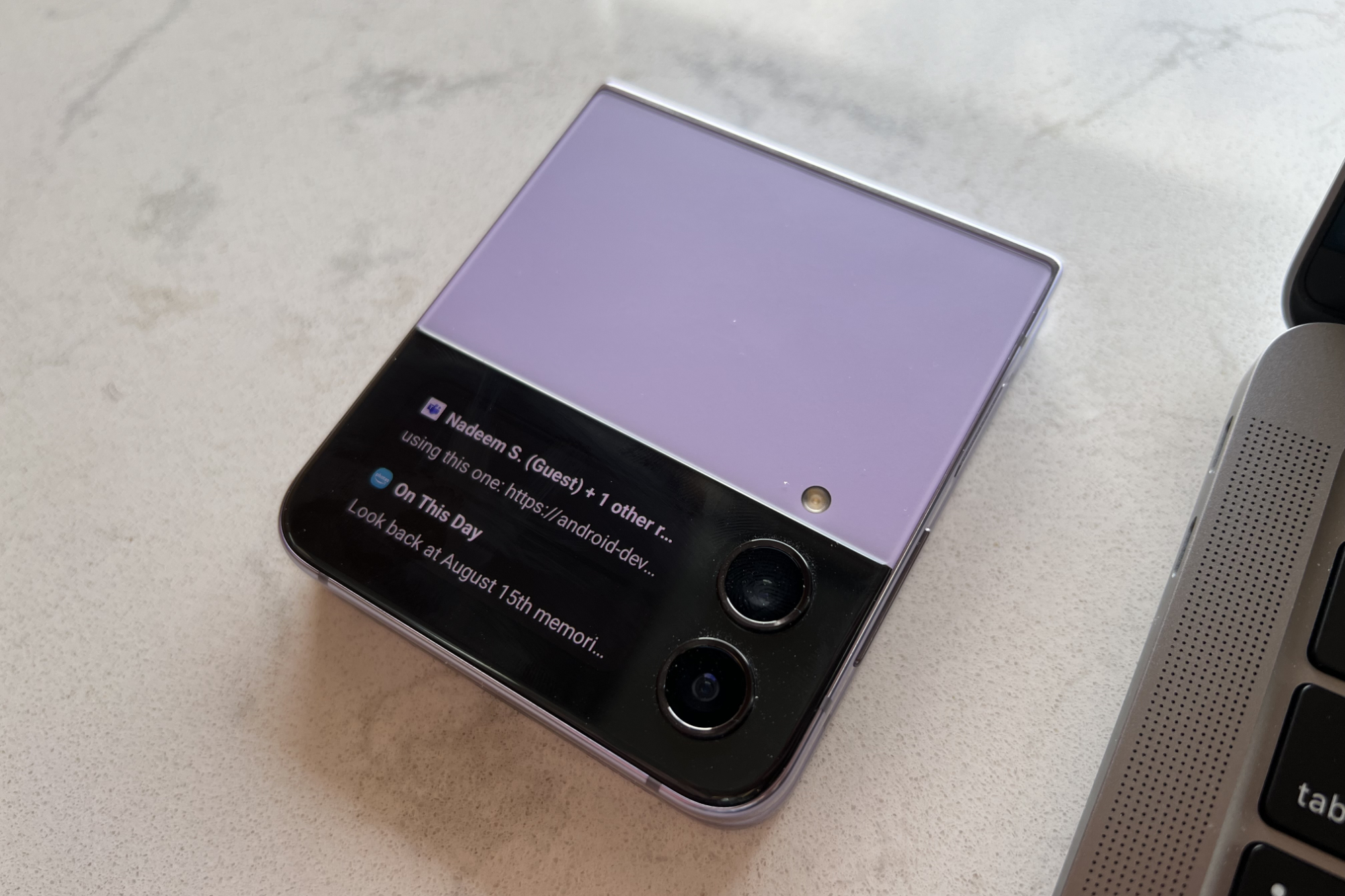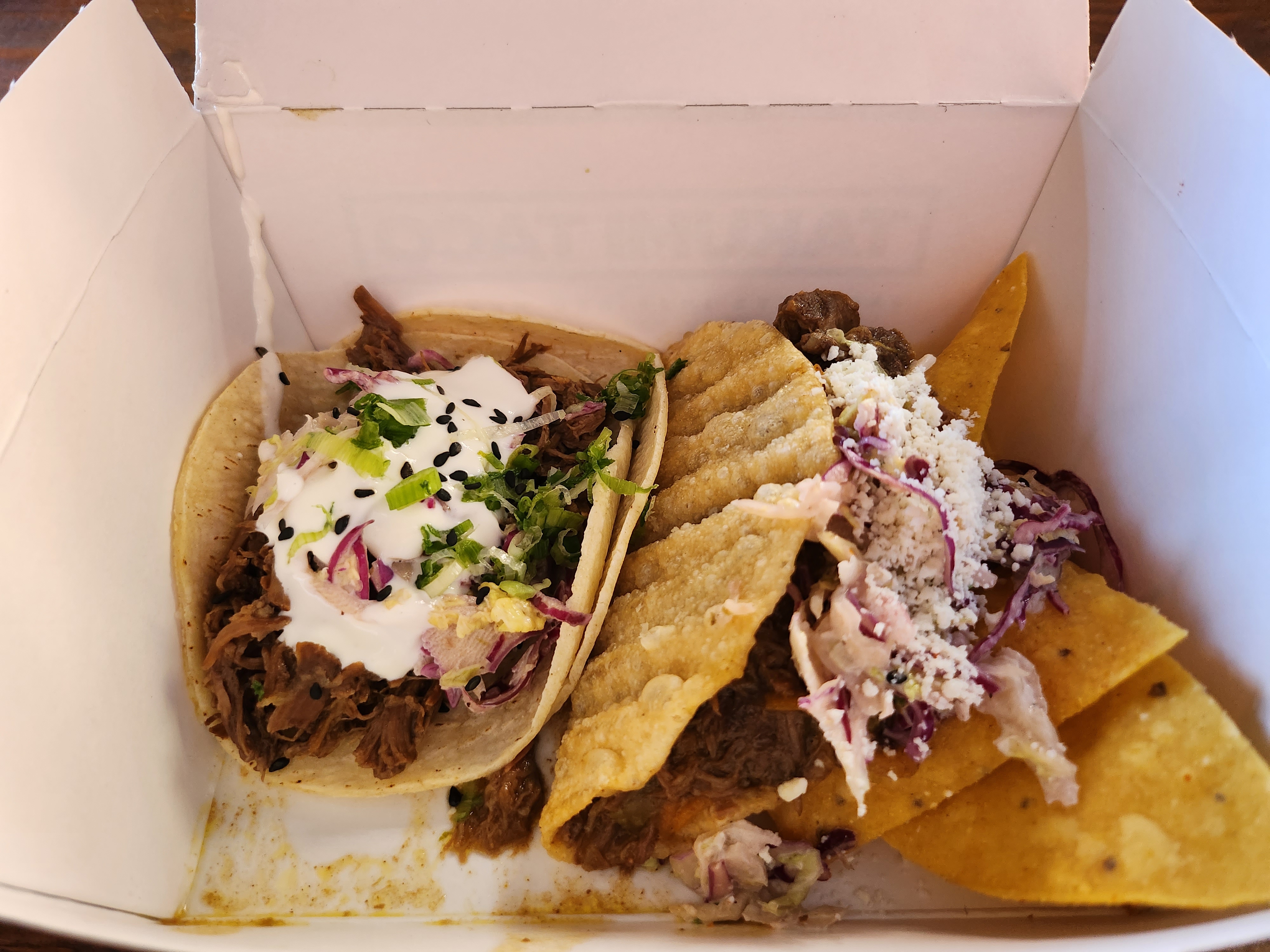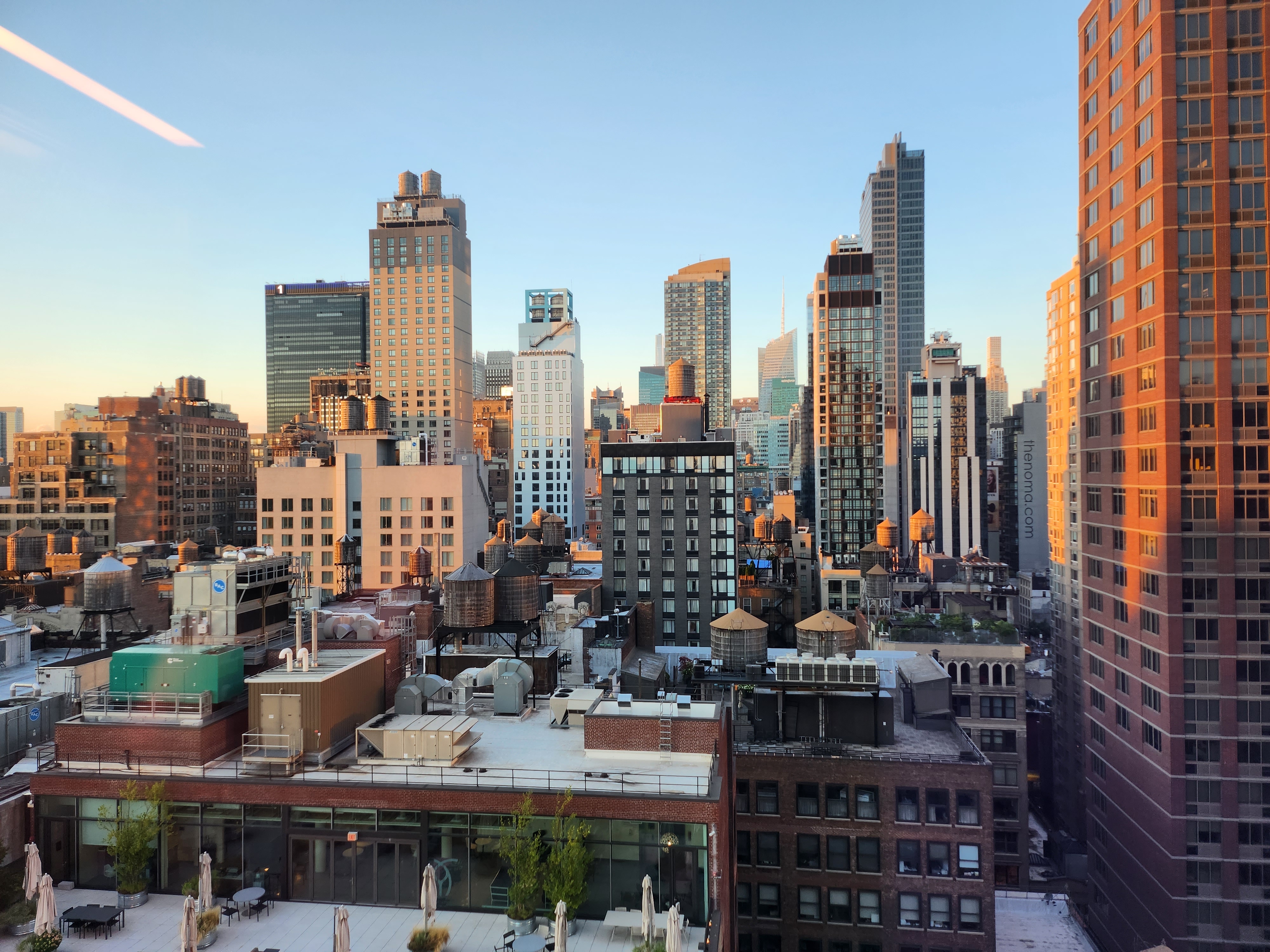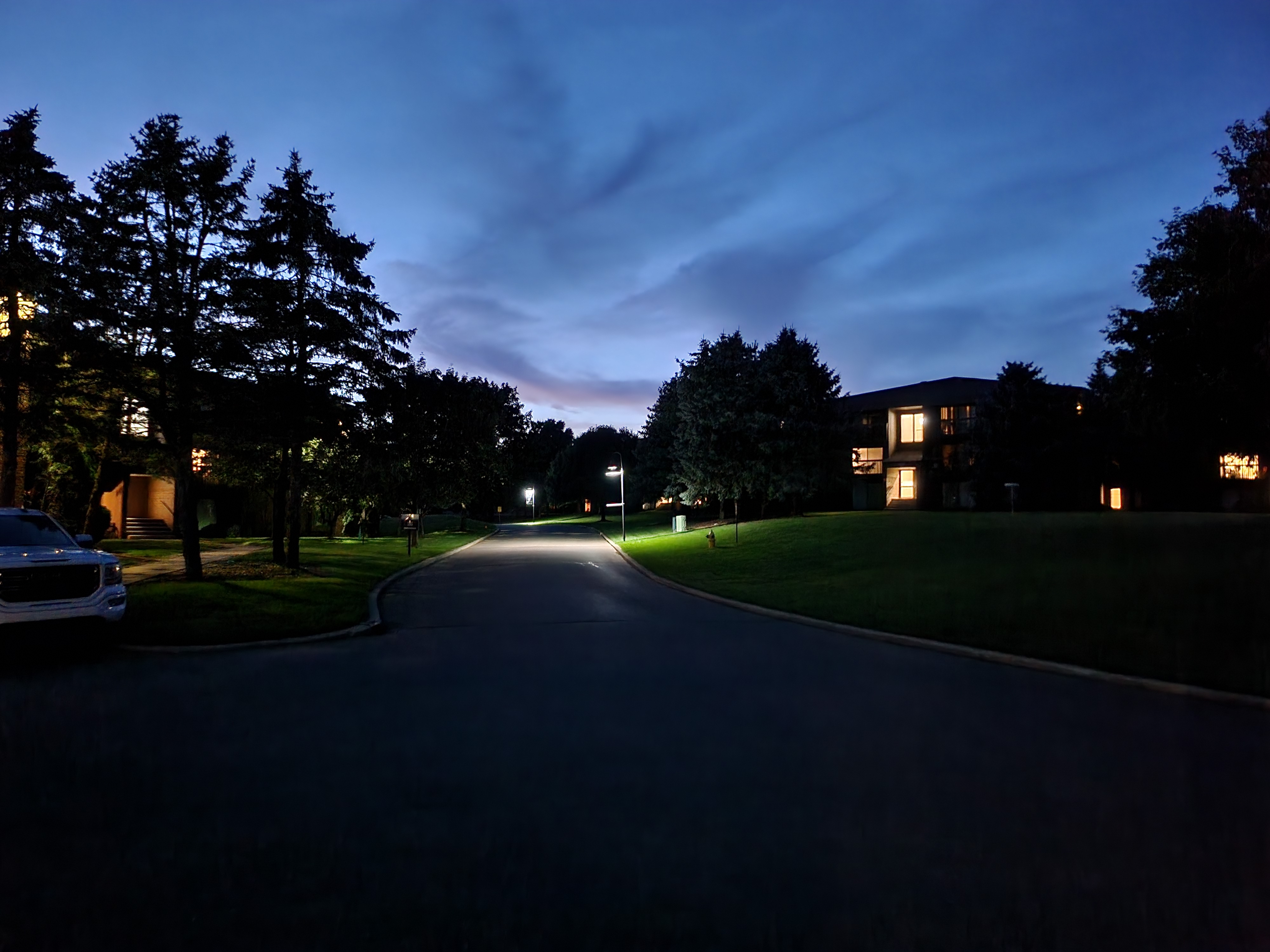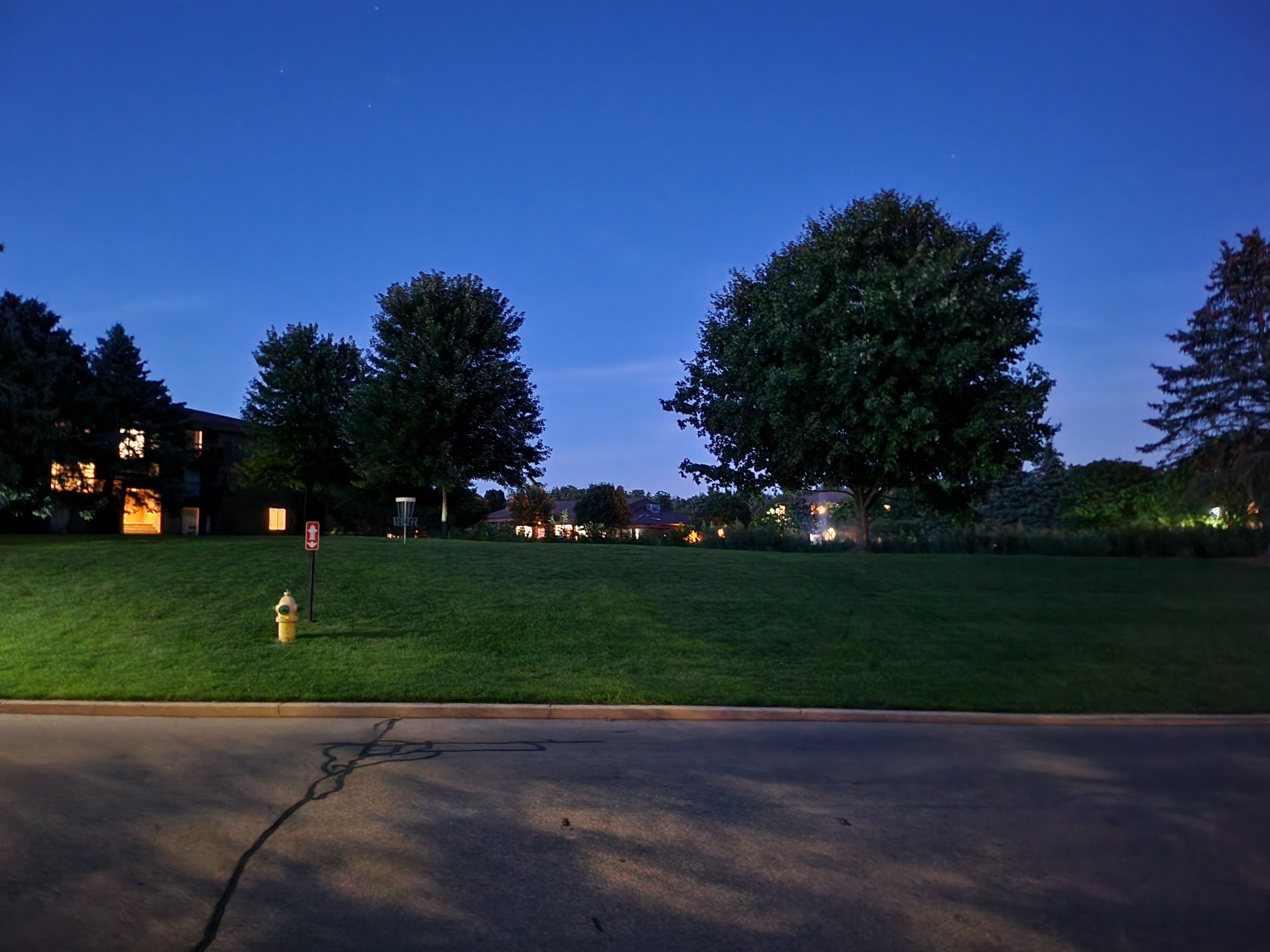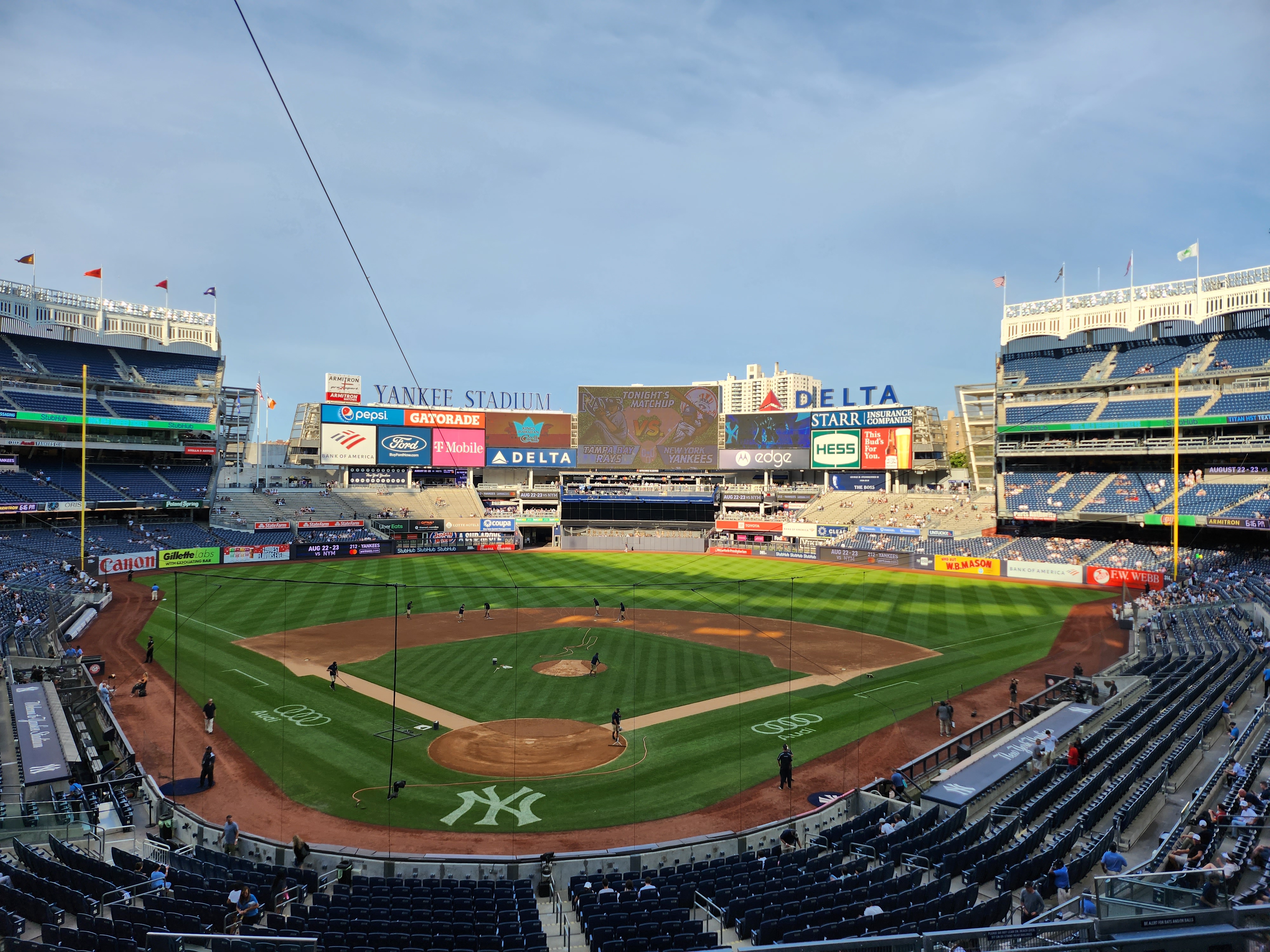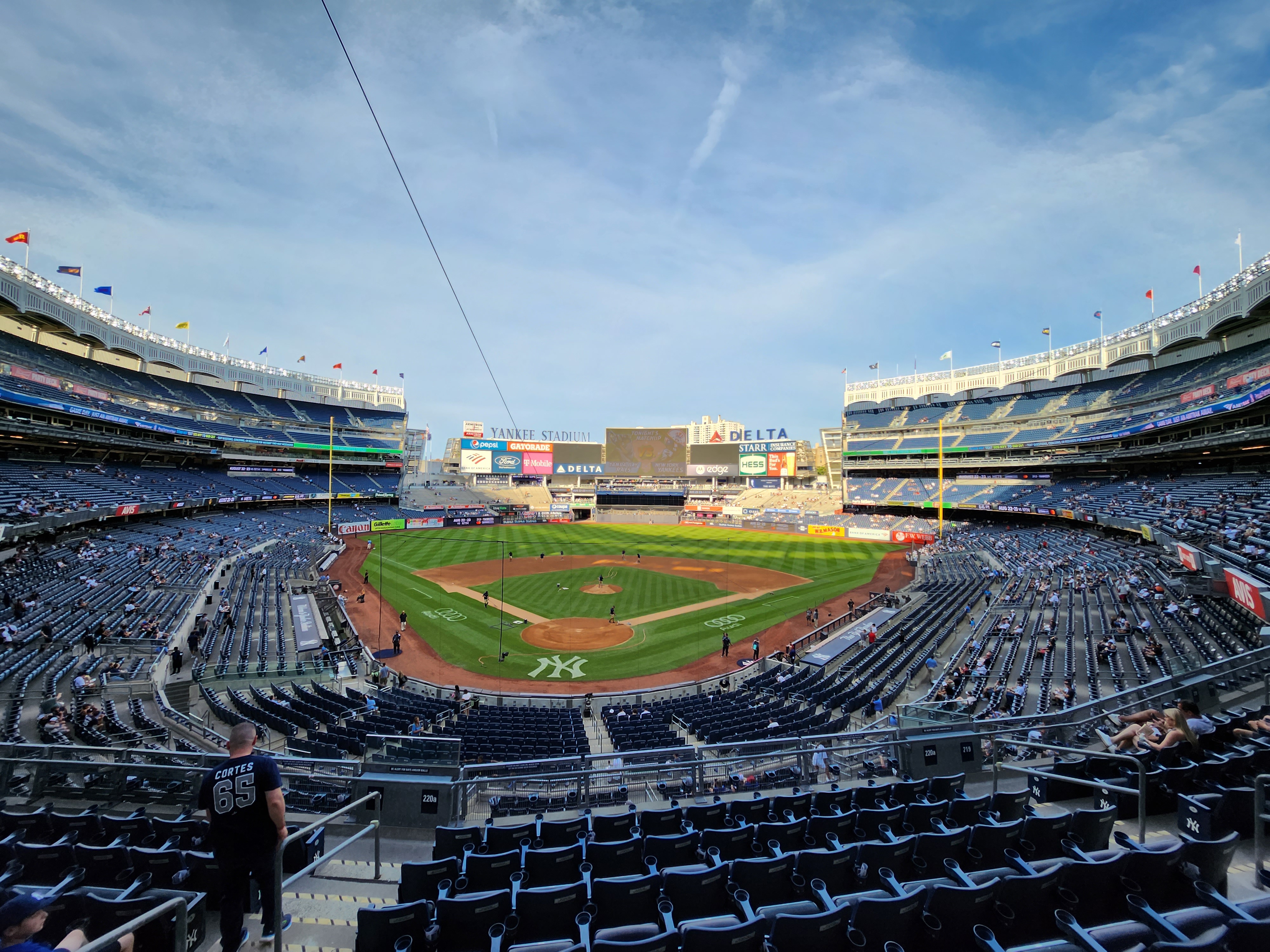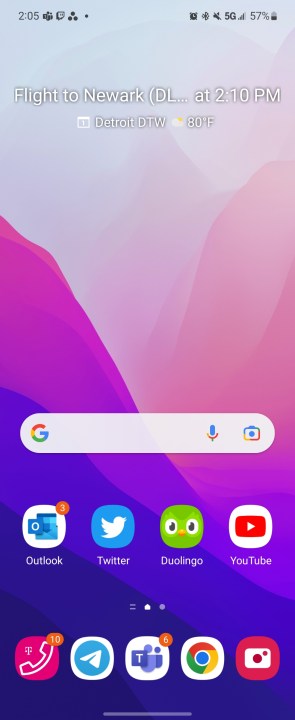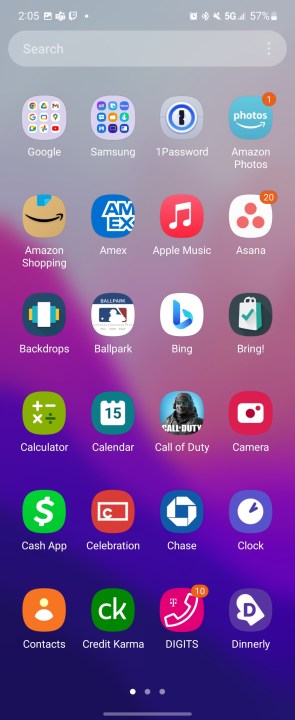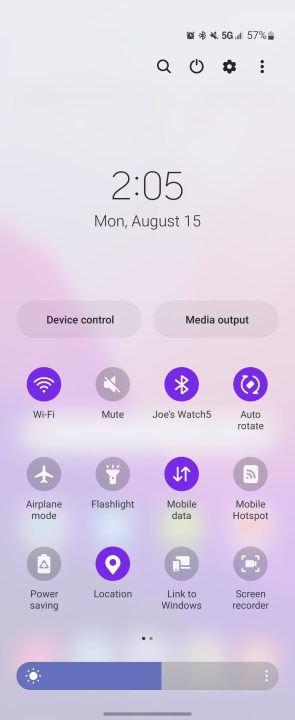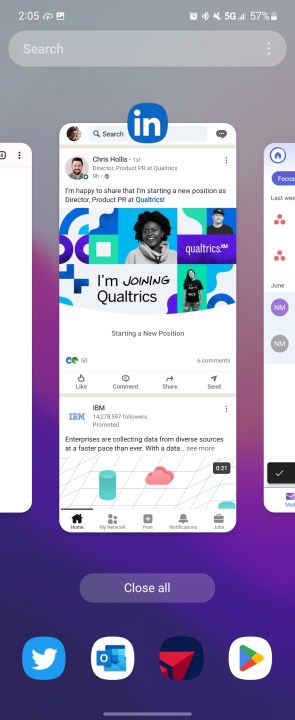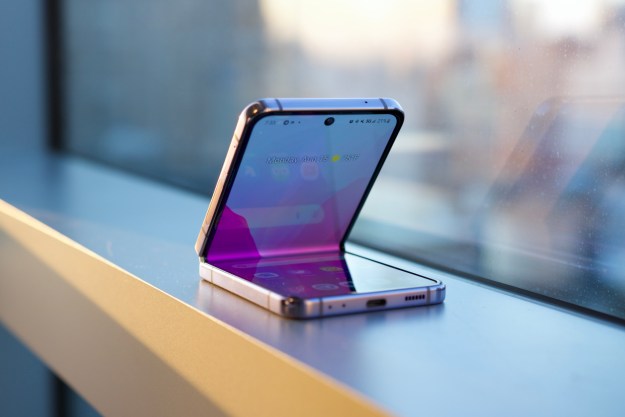
“The Galaxy Z Flip 4 may not be a revolutionary year-over-year upgrade, but it stands tall as one of the best folding smartphones you can buy in 2022. It's sleeker, faster, and more reliable than ever.”
- Flatter design looks and feels fantastic
- Bespoke customization is unmatched
- Excellent main display
- Blazing fast performance
- Good, fun cameras
- Battery still only lasts a day
- Limited cover screen functionality
The Samsung Galaxy Z Flip 4 is one of the best folding smartphones you can buy in 2022. Simultaneously, it’s also one of the most boring compared to its predecessor. It’s a fascinating place for the foldable niche to already be. Over the span of only three years, foldables have gone from a breakthrough niche to “just another” smartphone option you can buy. Samsung, specifically, has already gotten so good at the folding formula that it doesn’t have to reinvent the wheel every year. It just has to keep doing what worked the year before.
- Samsung Galaxy Z Flip 4 design
- Galaxy Z Flip 4 screens
- Galaxy Z Flip 4 performance
- Galaxy Z Flip 4 cameras
- Galaxy Z Flip 4 battery life and charging
- Galaxy Z Flip 4 software
- A second opinion on the Samsung Galaxy Z Flip 4
- Samsung Galaxy Z Flip 4 price and availability
- The Samsung Galaxy Z Flip 4 is the foldable you should buy
This year’s Galaxy Z Fold 4 and Z Flip 4 perfectly embody this. But where our Galaxy Z Fold 4 review found some fairly significant changes, that sense of repetition is especially prevalent with the Flip. Compared to the Flip 3, there’s not much new with the Flip 4. It has a slightly tweaked design, a camera that’s a little better, a newer chipset, and a marginally larger battery. It all makes the phone sound quite dull on paper. However, after using the Galaxy Z Flip 4 as my daily driver for the past few days, “dull” is the last word I’d use to describe it.
Is the Galaxy Z Flip 4 a substantial improvement over the Flip 3? No. But is it one of the best foldable phones you can buy today? Absolutely.
Samsung Galaxy Z Flip 4 design
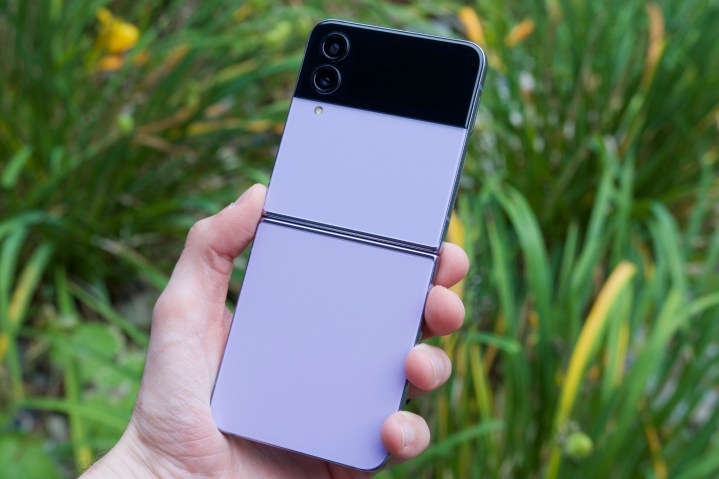
If you’ve seen the Galaxy Z Flip 3 before, you’ll be right at home with the Galaxy Z Flip 4. If you haven’t seen a Flip 3, the Flip 4 is essentially a reimagining of the flip phone for the modern era. When it’s open, the Flip 4 looks like any other smartphone — touting a large display, centered hole-punch camera cutout, and slim bezels. But the magic happens when you close the Flip 4. Snap the phone shut, and its hinge mechanism turns it into a compact square you can slide into the tightest of pockets and the smallest of bags.
Samsung made a handful of design improvements this year, starting with the Flip 4’s aesthetics. The rear glass panels have a frostier, matte finish compared to the Flip 3, the frame is flatter, and the hinge holding the phone together is slightly smaller than before. On paper, these changes sound like peanuts. But in practice, they take the Flip 3’s already excellent design and make it even better. The matte glass panels feel luxurious while hiding fingerprints, the flat frame gives the Z Flip 4 an even more distinctive look, and the new hinge — as marginal as it is — does give the Flip 4 a smaller overall footprint.
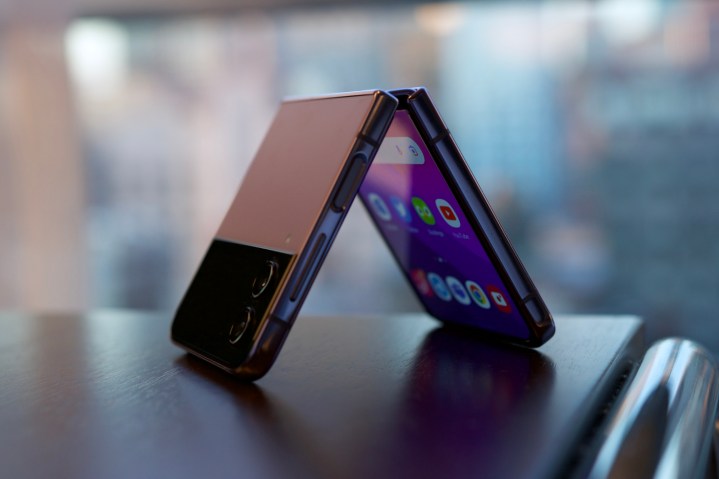
Speaking of the hinge, it feels every bit as sturdy and reliable as it did on the Flip 3. Like that phone, Samsung says the Z Flip 4 should survive over 200,000 folds during its lifetime — equating to about 100 folds per day throughout five years of use. While I can’t yet speak to how the hinge will feel after a year or two of constant usage, it’s been a champ during my time with the phone.
It opens and closes smoothly, though with enough resistance that it doesn’t feel flimsy. The hinge is also strong enough to be propped up at almost any angle, allowing you to sit the Z Flip 4 on a table with the screen up and facing at you — perfect for hands-free movie watching, video calls, etc.
As for the rest of the phone’s durability, the glass panels and cover screen are covered with Corning Gorilla Glass Victus, the frame is Samsung’s own Armor Aluminum concoction, and the entire device is protected by an IPX8 water-resistance rating (enough to submerge it in up to 1.5 meters of freshwater for up to 30 minutes). There’s still no dust resistance, but for a folding phone, the Galaxy Z Flip 4 is about as durable as it gets.
After two weeks of regular use as my go-to handset, the Galaxy Z Flip 4 has held up just as well as any of my non-folding phones. From the glass panels, cover screen, and main display, everything appears to be in tip-top shape. And that’s without babying the phone at all. I’ve tossed it on coffee shop tables, used it while out in a light drizzle, and (frequently) whipped it open with a flick of the wrist. Just like its predecessor, the Z Flip 4 isn’t a phone you have to baby.

As much as I appreciate the Flip 4’s durability, my favorite design trick is its emphasis on style. By default, Samsung’s website and third-party retailers carry the phone in four hues: Bora Purple, Blue, Pink Gold, and Graphite. Bora Purple is the color Samsung sent me, and I think it’s my favorite of the bunch. It’s a muted lavender color that’s distinctive without being obnoxious, and it contrasts beautifully with the black cover screen. Plus, it looks phenomenal next to the Bora Purple Galaxy Buds 2 Pro.

But if none of those colors catch your eye, Samsung’s website also lets you design the Flip 4 using its Bespoke Studio. Here, Samsung lets you pick and choose the exact colors you want for the Flip 4’s front panel, back panel, and frame – resulting in over 70 possible combinations. It’s unlike anything else available today in the smartphone world and is arguably one of the Flip 4’s best features.
This is some of the most fun I’ve had with a phone all year.
Furthermore, there’s the fun factor that naturally comes with a device like the Galaxy Z Flip 4. It’s not something I can measure with benchmarks or technical analysis, but I can confidently say that this is some of the most fun I’ve had with a phone all year.
From snapping it shut after using an app, propping it up on the counter to watch a YouTube video while I cook dinner, or taking a phone call with the phone slightly bent to resemble the handsets of yesteryear, there are so many unique qualities about the Flip 4 that simply can’t be replicated on a non-folding counterpart. That may not mean anything to some people, but to me, it’s made using the Z Flip 4 an experience I look forward to every time I take it out of my pocket.
Galaxy Z Flip 4 screens
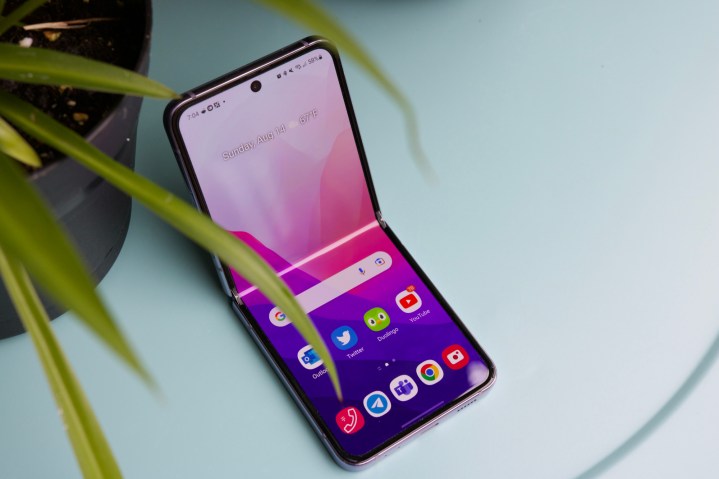
We have two screens on the Galaxy Z Flip 4 to judge, but we’ll start with the one you’ll spend the most time with. When opened, the Z Flip 4 treats you to a 6.7-inch Dynamic AMOLED 2X panel. It’s a screen with a 2640 x 1080 resolution, HDR10+ support, 1,200 nits of peak brightness, and a variable refresh rate that scales up to 120Hz and all the way down to 1Hz.
In practice, the screen on the Z Flip 4 looks outstanding. Colors are lusciously vibrant, viewing angles are excellent, and it gets very bright when you need it. Samsung flagships are famous for having some of the best smartphone screens on the market, and even with the foldable form, the Z Flip 4 is no different.
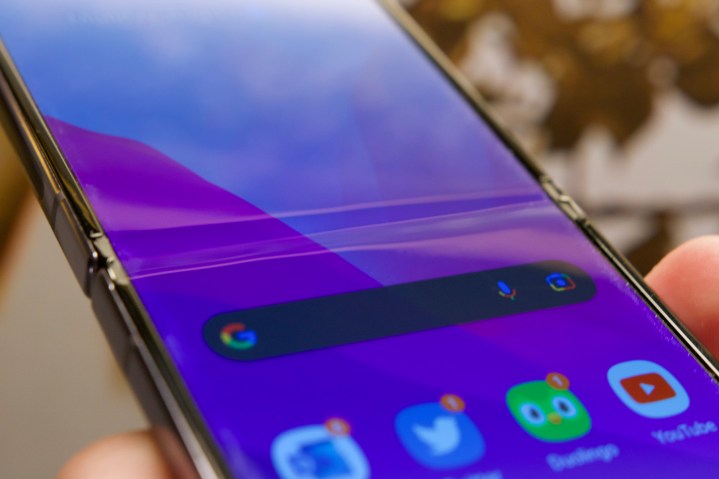
But what about the crease? Every Z Flip handset has a noticeable crease in the middle of the screen where the hinge folds shut, and despite changes to its hinge, the Z Flip 4 is no different — despite what rumors suggested. The crease is still there. You can clearly see it in certain lighting conditions, and you’ll feel it when swiping your finger across it.
But after just a few hours of use, the crease becomes something you subconsciously ignore (just like the notch on an iPhone). I still see it with direct sunlight and feel it when doom-scrolling Twitter, but it’s not something that ever gets in my way of using the Flip 4.

And we have the cover screen. Despite rumors of Samsung enlarging the Flip 4’s cover screen, it’s the same 1.9-inch Super AMOLED 512 x 260 resolution screen that we had on the Flip 3. And that means the functionality is mostly the same, too. You swipe right to see notifications, swipe up to access cards in Samsung Wallet, swipe down to adjust a handful of quick settings, and swipe left to view a variety of widgets.
For checking notifications, sending quick replies to text messages, viewing upcoming calendar appointments, or enabling SmartThings scenes, the cover screen on the Flip 4 is great. It also serves as a handy viewfinder, allowing you to take photos/videos of yourself with the main and ultrawide cameras and see what’s in your shot. But I can’t help but wish there was more I could do.
I’d love to be able to reply to Telegram or Microsoft Teams messages, show QR codes/boarding passes stored in Samsung Wallet, view conversations from my messaging apps, etc. Trying to replicate your home screen and all of your apps on a 1.9-inch canvas would be a bad idea, and Samsung’s right not to have done that. But even with the limited real estate, I think there’s still room to grow here. I love using the Flip 4’s cover screen for fast interactions, and I’d love to see it expand a bit more than what’s currently available.
Galaxy Z Flip 4 performance
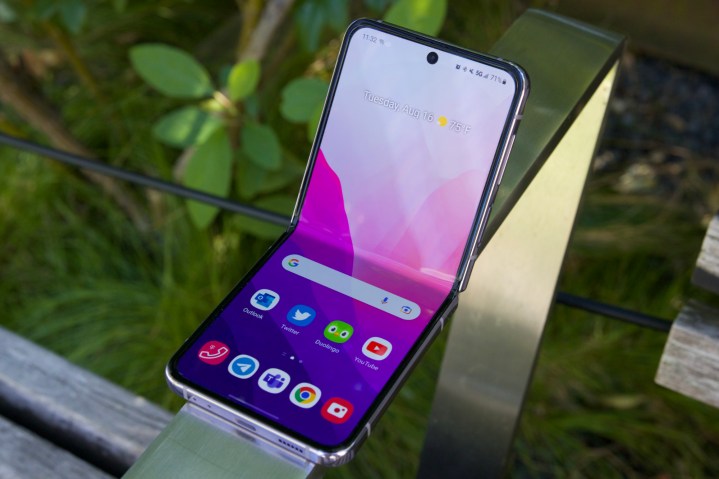
The Galaxy Z Flip lineup has never had a problem regarding internal horsepower. The original Z Flip donned a Snapdragon 855+, the Z Flip 5G had an 865 5G+, and the Z Flip 3 shipped with a Snapdragon 888 — all top-of-the-line Qualcomm chips for their time. The Galaxy Z Flip 4 is no different, coming with Qualcomm’s latest Snapdragon 8+ Gen 1.
As we’ve seen from other phones with the 8+ Gen 1, the Galaxy Z Flip 4 has all of the performance you could ask for. Apps open instantly, menus scroll flawlessly, and graphically demanding games like Call of Duty: Mobile play without a hitch. The Z Flip 4 can heat up during more demanding tasks (such as long gaming sessions or multiple hours of hotspot use), but it never gets to the point where it’s uncomfortable to hold. For a foldable phone this slim, it’s pretty impressive.
The Galaxy Z Flip 4 has all of the performance you could ask for.
The only potential irritant is the Z Flip 4’s available RAM. Just like last year (and the year before), the Galaxy Z Flip 4 has 8GB of RAM for all storage models. It’s enough to juggle a handful of apps at a time, but if you want to be a multitasking champ with a dozen or more apps open at once, 8GB may be a touch too limiting. And if you’re that concerned about multitasking, you’re probably better off with the phone/tablet form factor provided by the Galaxy Z Fold 4 anyway.
Galaxy Z Flip 4 cameras
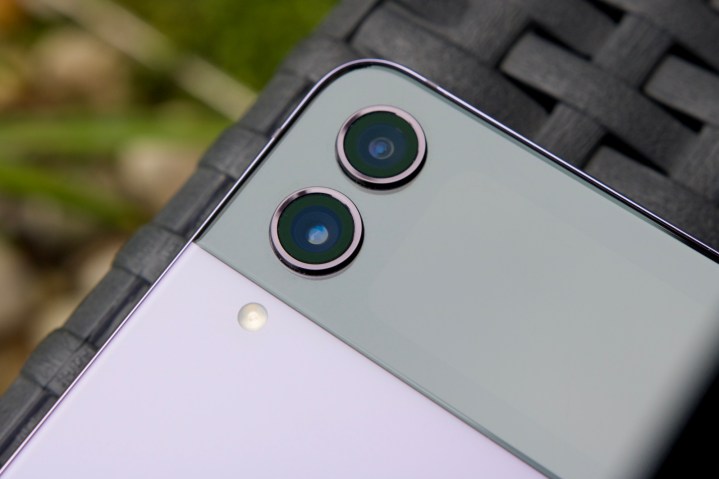
Next, let’s talk cameras. The Galaxy Z Flip 4 has a fairly basic offering in this department — including a 12MP primary camera, a 12MP ultrawide camera, and a 10MP selfie camera. Those are all the same megapixel counts as what you’ll find on the Flip 3, but Samsung says the primary camera on the Flip 4 is 65% brighter this generation.
That’s all to say that the camera experience on the Z Flip 4 is a very minor improvement over the Flip 3. It’s a solid camera package and should serve most people just fine, but this also isn’t a camera system that’ll be dethroning the Pixel 6 Pro or iPhone 13 Pro any time soon.
In typical Samsung fashion, photos straight out of the Galaxy Z Flip 4 are very saturated with big, vibrant colors. They aren’t always the most true-to-life, but they’re eye-catching and ready to share on social media — no editing required. Sometimes this works in the Z Flip 4’s favor, turning what would otherwise be a dull shot into something that pops.
But it can also work against the phone. I’ve noticed that, especially with greens and yellows, the Z Flip 4 has a tendency to oversaturate them to the point that they look artificial.
What about lowlight photography? Thanks to the 65% brighter sensor, the Galaxy Z Flip 4 handles nighttime photos quite well. The photos below were all taken around 9:20 p.m. and well past sunset. Even so, the Galaxy Z Flip 4 manages to brighten the scene so you can clearly make out the green grass, evening sky, and details in the road in the second photo. The third photo of the flowers is a bit soft with the details, but the colors look great.
As for the ultrawide camera, I’ve been mostly happy with its performance. You lose some of the finer detail you’d otherwise get with the 12MP primary sensor, but the 123-degree field of view is convenient, and color reproduction is very similar to the primary shooter — saturated and full of vibrancy. It’s not the most dazzling ultrawide sensor I’ve ever used, but it’s consistent, reliable, and a welcome addition to the Flip 4.
Finally, there’s the 10MP selfie camera. It’s a perfectly adequate sensor and works well for selfies and video calls. But on the rare occasions I wanted to snap a photo of myself, I found I was ignoring the 10MP selfie camera and instead using the 12MP primary camera. Thanks to the Flip 4’s folding design and cover screen, you can easily take photos and videos from the 12MP main and ultrawide cameras and preview them directly on the cover screen. And new this year, you can view the full preview of the photo in its actual aspect ratio, not just a cropped-in version like on the Flip 3.
- 1. Photo from Z Flip 4’s 10MP selfie camera
- 2. Photo from Z Flip 4’s 12MP main camera
Side by side, the difference in quality between the 10MP selfie camera and the 12MP main camera is easy to see. Both photos were taken seconds apart from each other and in Portrait mode on the Flip 4. The photo from the 10MP camera is fine, but it also has an unpleasing haze throughout and noticeably softer details on my face. By comparison, the selfie from the 12MP main camera has better colors, detail, and was easier to capture while holding the Flip 4 closed.

And that’s just scratching the surface of how the Galaxy Z Flip 4’s camera system stands out from competing handsets. You can also prop up the Flip 4 on a table or other flat surface and easily capture hands-free photos no iPhone or Pixel can come close to mimicking. On vacation with your partner and want a cute photo together? Just use open the Flip 4 and place it on something in front of you — no hunting for a random stranger to be your photographer required.
It’s because of these unique use cases that I’m less bothered by some of the technical shortcomings of the Z Flip 4’s camera. It’s not the very best out there, but it churns out good-looking photos, handles lowlight situations well, and comes with unique shooting modes none of my other phones have.
Galaxy Z Flip 4 battery life and charging

One of the weakest aspects of the Z Flip 3 — if not the weakest — was its battery life. The Galaxy Z Flip 3 was a one-day phone at its best and often required you to look for a charger before the day was over. Hearing the battery complaints loud and clear, Samsung made a couple of key changes with the Z Flip 4. In addition to the more power-efficient Snapdragon 8+ Gen 1 chipset, the Z Flip 4 also comes with a 3,700 mAh dual-cell battery, a 500 mAh upgrade over the 3,300 mAh unit in its predecessor.
The good news? Battery life on the Galaxy Z Flip 4 is markedly better than it was on the Flip 3. The bad news? It’s still only good enough for one full day of use. One of my better days with the Flip 4 saw me end the day at 10:53 PM with 23% battery still left in the tank. That was following 14 hours of total use time with 3 hours and 42 minutes of screen on time — including over an hour of YouTube, 30+ minutes of browsing Twitter, 16 minutes of Reddit scrolling, a 10-minute Duolingo session, etc. Another day saw the phone reach 14 hours and 52 minutes of use time with 15% battery remaining. That was following 2 hours and 23 minutes of screen time consisting of a 30+ minute Teams video call, 30 minutes of Twitter, calling and tracking a Lyft ride, and frequent use of the Delta app while jumping on a couple of flights.
You can more comfortably get through a full day on the Flip 4 than you ever could with the Flip 3, but a single day of use is still where the phone tops out. If you need a phone to last a day and a half or two days per charge, you’ll want to steer your attention towards devices like the Asus ROG Phone 6 and Zenfone 9.
You can more comfortably get through a full day on the Flip 4 than you ever could with the Flip 3.
Also improved on the Galaxy Z Flip 4 is wired charging. Where last year’s Flip 3 maxed out at 15W wired charging speeds, the Flip 4 cranks things up to 25W. It’s a far cry from phones like the OnePlus 10T delivering up to 150W charging, but it’s a welcome improvement nonetheless. 10 minutes of charging takes the Flip 4 from 5 – 23% battery, 25 minutes gets you from 5 – 47%, and going from 5% remaining to a full 100% battery takes about an hour and 16 minutes. And if you aren’t in a hurry, the Galaxy Z Flip 4 also supports 10W wireless charging (plus 4.5W reverse wireless charging).
Galaxy Z Flip 4 software
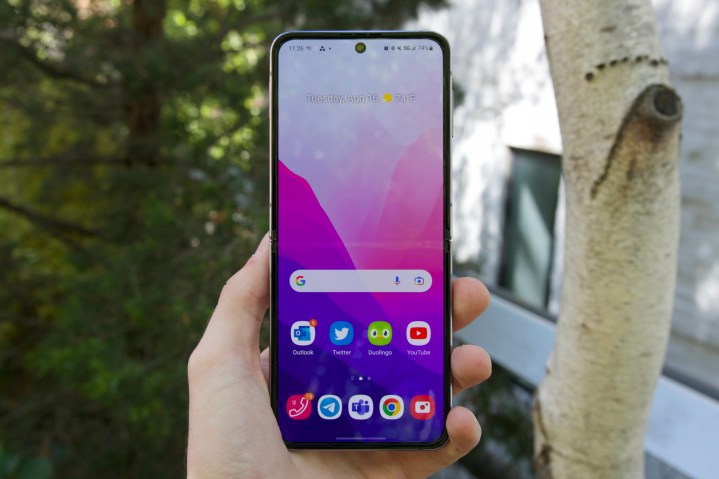
The Galaxy Z Flip 4 ships with Android 12 and Samsung’s One UI 4.1.1 interface layered on top. It’s also backed by Samsung’s usual update promise, meaning you can expect four major Android updates and five years of security patches.
If you’ve used a modern Samsung phone within the last couple of years, you’ll be right at home with the software experience on the Flip 4. Samsung’s One UI aesthetics aren’t my personal favorite, but the interface is fast, fluid, and keeps everything feeling snappy. And as is the case with all Samsung phones, there are ample features/settings to keep you preoccupied. You can change the shortcuts that appear on the lock screen, enable Edge panels for handy app shortcuts, use Link to Windows for seamless device syncing with your PC, add custom shortcuts for the power button, run apps in a windowed view on your screen, etc.
In addition to the usual array of Samsung features, there are also a few tricks exclusive to the Z Flip form factor — the most notable being the “Flex mode panel.” If you enable Flex mode for an app and open that app with the Z Flip 4 propped upright, the app moves to the top portion of the screen and leaves the bottom half available for various controls. From the bottom half of your screen, you can view the notification panel, take a screenshot, change the brightness/volume, or use the bottom part of the screen as a trackpad for navigating the app shown above.
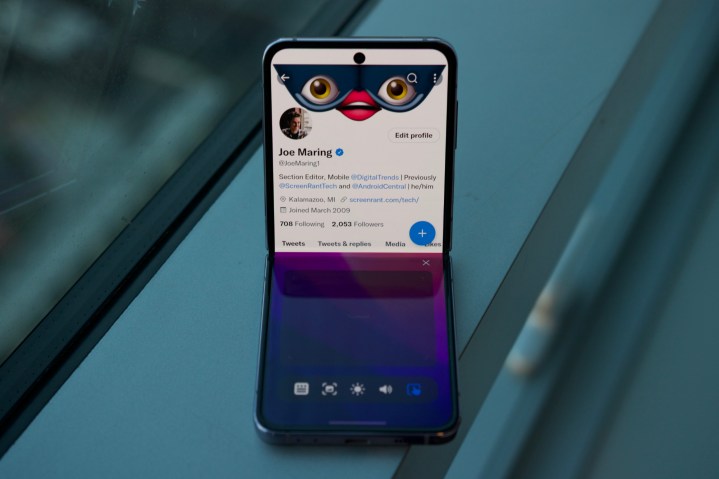
Not every application formats nicely in Flex mode, but I do love that Samsung lets you try it with any app you have to see what works and what doesn’t. It’s not something I use all the time, and the practicality of the feature is often questionable at best, but I still like that it’s there. Plus, for certain applications like YouTube and the camera app, they’ll automatically shift UI elements around when half-folding the Flip 4. The Fold 4 remains the go-to foldable for anyone trying to make the most out of their device’s screen real estate, but I do appreciate Samsung putting these tools at your disposal so you can really do whatever you’d like with the Flip 4’s unique design.
A second opinion on the Samsung Galaxy Z Flip 4
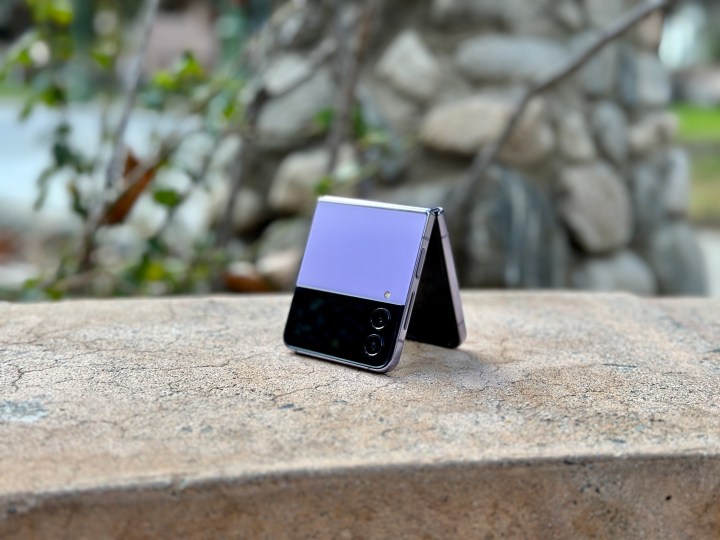
As someone who has been an iPhone user most of her life, Digital Trends’ Mobile Staff Writer, Christine Romero-Chan, has been enjoying her time with the Samsung Galaxy Z Flip 4. In fact, though she has been skeptical of folding phones before, her time with the Galaxy Z Flip 4 has turned her into a believer, and she’s excited about all the possibilities a folding phone can bring.
She thinks that the Samsung Galaxy Z Flip 4 is the perfect compact size, as it can fit nicely in her front pockets (women’s clothes are notorious for tiny pockets) when closed. It makes more sense than a foldable that opens up into a small tablet size, at least. However, she does think that it’s a little difficult to open up the Flip 4 with one hand and use it single-handedly when one has smaller hands. Of course, the crease can be irksome since it’s always visible, and you’ll feel it when you touch the screen, but that’s a problem with most foldables — at least until the technology for folding displays improves, like on the Oppo Find N2.
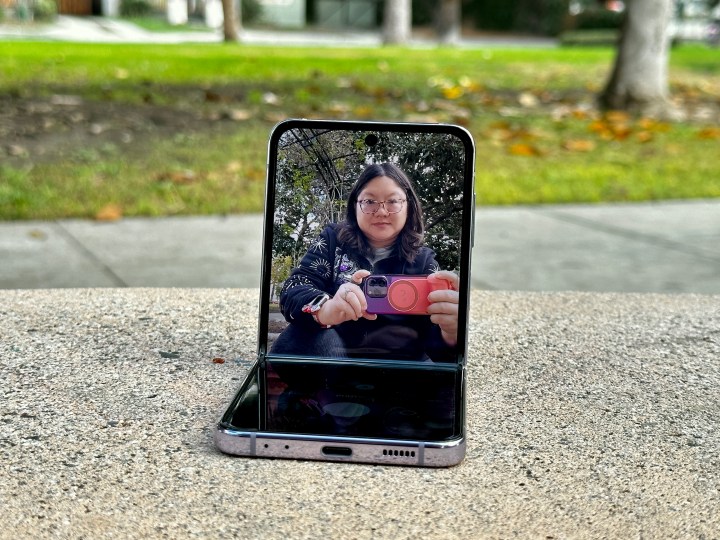
Still, one of her favorite things about the Samsung Galaxy Z Flip 4 is the ability to use it half-open in Flex mode, which is perfect for photography. Since one of the things Christine does most with her phone is taking pictures, being able to prop the camera up without the need for third-party accessories is a huge advantage. Flex mode is great for hands-free photography, and you can even use the 1.9-inch cover screen as a viewfinder for selfies, which is also incredibly handy. Speaking of the cover screen, she’s a fan of how informative it can be, despite the minimalism, allowing you to get information in a quick view without having to open the device.
The Samsung Galaxy Z Flip 4 is not perfect by any means, but it is a great foldable phone for anyone who is intrigued and willing to give it a try.
Samsung Galaxy Z Flip 4 price and availability
The Samsung Galaxy Z Flip 4 starts at $1,000 in the U.S. for the base model with 128GB of storage. You can upgrade to 256GB or 512GB if you need more room, but doing so will set you back $1,100 and $1,220, respectively. The phone is available for purchase now.
As the story often goes with Samsung phones, however, the retail price isn’t what you’ll end up paying. Whether you buy the Z Flip 4 direct from Samsung, through your carrier, or from a third-party retailer like Amazon or Best Buy, chances are you’ll find some sort of promotion to make the phone considerably more affordable.
The Samsung Galaxy Z Flip 4 is the foldable you should buy
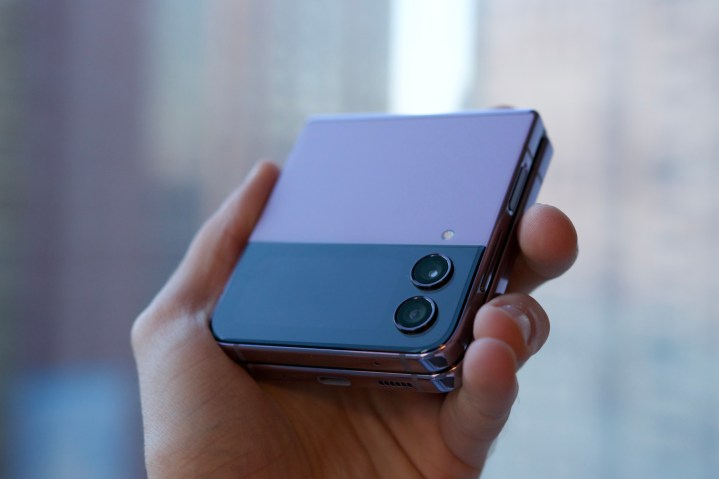
I understand why some people have dismissed the Galaxy Z Flip 4 as a “boring” phone this year. It’s about as iterative as a yearly update gets. Other than a slightly tweaked design, an upgraded chip, a larger battery, and a faster charger, it’s effectively the same Z Flip that Samsung released last year. But that’s precisely why the Z Flip 4 works so well.
Of the ‘fold’ and ‘flip’ foldable designs that the industry has seemingly settled on, the Galaxy Z Flip 4 is the best damn version of the latter you can buy. The refreshed design looks and feels as good as I could have hoped for, the hinge feels fantastic, the processor has more power than you could ever need, and the display looks amazing. I wish Samsung could have extended battery life even more and really taken the cover screen to the next level, but even without those things, the Z Flip 4 is still a joy to use.
If you want a flagship with industry-leading cameras, multi-day battery life, or lightning-fast charging, there are plenty of other options for you to choose from. But if you’re OK sacrificing some of those things for a design unlike anything else, the Galaxy Z Flip 4 is the best in its class. It’s not the most technically impressive phone in every single category, but it’s stylish, adorable, and fun in ways that traditional slab smartphones will never be able to match. And the areas where the Flip 3 struggled — such as battery life and charging — are noticeably better on the Flip 4. Combine that unique approach with precision execution in so many categories, and the Galaxy Z Flip 4 stands tall as one of my favorite smartphones of the year. No matter how boring it’s supposed to be.
Editors' Recommendations
- Your Pixel 7 is about to get a whole lot less buggy — here’s why
- Will my phone automatically change for daylight saving time?
- Watch the Galaxy S23 Ultra and iPhone 14 Pro Max face off in brutal drop test
- When is my phone getting Android 14? Here’s everything we know
- Google Pixel Tablet: news, release date and price rumors, and more


